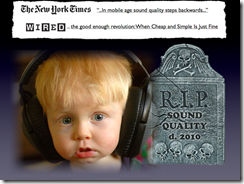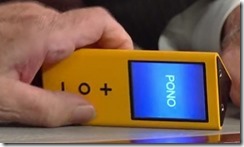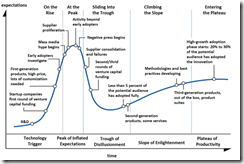 My Jan 2011 blog post “11 new technologies to impact our life in 2011” has been my most successful topic in term of audience and traffic, so I thought I will do it again. With the explosion and acceleration of science and technologies, 2 years is already a long time, so here is a short highlight of 10 new technologies that will change your life in 2013:
My Jan 2011 blog post “11 new technologies to impact our life in 2011” has been my most successful topic in term of audience and traffic, so I thought I will do it again. With the explosion and acceleration of science and technologies, 2 years is already a long time, so here is a short highlight of 10 new technologies that will change your life in 2013:
1- 3D printing
A 3D printer is a device able of outputting physical objects meaning they can create real, solid objects from digital data. They have been in development labs for quite some time but are now hitting our real life and are starting to revolution prototyping and digital manufacturing. There are several technologies enabling 3D printers, such as stereolithography, material jetting, polyjet matrix, DLP projection, Fused Deposition Modelling, Binder Jetting, selective laser sintering or selective laser melting, etc… and a wide range of 3D printers and online services are now available for industrial and manufacturing applications. This is only the first step, in the second step it is already becoming available to the public consumer with Personal 3D Printers or kits ranging between $1.000 to $3,000. We can predict a Desktop 3D printer will cost a few hundred dollars in 2015 …imagine a future where instead of going in a store to buy an object, it will be delivered electronically to your computer and created on your home 3D printer… 3D printing is going mainstream, future is coming to your door!
life and are starting to revolution prototyping and digital manufacturing. There are several technologies enabling 3D printers, such as stereolithography, material jetting, polyjet matrix, DLP projection, Fused Deposition Modelling, Binder Jetting, selective laser sintering or selective laser melting, etc… and a wide range of 3D printers and online services are now available for industrial and manufacturing applications. This is only the first step, in the second step it is already becoming available to the public consumer with Personal 3D Printers or kits ranging between $1.000 to $3,000. We can predict a Desktop 3D printer will cost a few hundred dollars in 2015 …imagine a future where instead of going in a store to buy an object, it will be delivered electronically to your computer and created on your home 3D printer… 3D printing is going mainstream, future is coming to your door!
2- Mobile Payments and Mobile Wallets
Mobile payment or mobile wallet refer to a payment performed via a mobile device and managed by a financial institution (bank, credit card) or service providers (internet providers, wireless communications providers), enabled by technologies as Near  Field Communications or NFC. Newcomers are rushing to this huge market too and Paypal (owned by eBay) will be announcing next week it’s new mobile Point-of-Sale (available first in UK) at Mobile World Congress in Barcelona where Mobile Payment will be a big Buzz. Samsung and Visa are announcing a new global alliance to boost mobile payment and NFC. Technology has been available and secure for quite some time, banks and operators have been preparing for few years, and time has come for wide market adoption by shoppers and end users, as a very convenient alternative payment method to cash, check or credit card, carry digital coupons etc. Adoption has been spreading from Asia to Europe and is starting in North America, slower for regulations and technical reasons. In parallel social Commerce is also growing and American Express customers who link their cards to their Twitter accounts are now able make purchases with a tweet, I like that! A good justification to upgrade my Blackberry Torch to the Blackberry Z10 J
Field Communications or NFC. Newcomers are rushing to this huge market too and Paypal (owned by eBay) will be announcing next week it’s new mobile Point-of-Sale (available first in UK) at Mobile World Congress in Barcelona where Mobile Payment will be a big Buzz. Samsung and Visa are announcing a new global alliance to boost mobile payment and NFC. Technology has been available and secure for quite some time, banks and operators have been preparing for few years, and time has come for wide market adoption by shoppers and end users, as a very convenient alternative payment method to cash, check or credit card, carry digital coupons etc. Adoption has been spreading from Asia to Europe and is starting in North America, slower for regulations and technical reasons. In parallel social Commerce is also growing and American Express customers who link their cards to their Twitter accounts are now able make purchases with a tweet, I like that! A good justification to upgrade my Blackberry Torch to the Blackberry Z10 J
3- In Car Digital connection, Connected-to-Cloud cars and Self Controlled cars
I visited the Toronto Auto Show last week, and ff you have been in the market for a new car, you probably realised that Connected Cars are becoming ubiquitous with increased deployment of telematics and infotainment services. The Connected car is out in the streets, industry targets and predictions are: 
Over 20% of global vehicle sales in 2015 to include embedded connectivity solutions
Over 50% of global vehicles sales in 2015 to be connected (either by embedded tethered or smart phone integration)
Every car to be connected in multiple manners by 2025
As examples, Ford’s Cloud-Connected Car, the Evos Concept was announced at CES 2012, and
AT&T+General Motors are announcing to sell 4G LTE-connected cars, smart-cars with built-in Wi-Fi hot spots.
Leveraging several wireless technologies as Bluetooth, 4G, LTE, Satellite, Wi-Fi, Wimax, and M2M (Machine-to-Machine) embedded technologies, Your car is becoming a mobile device, with constant connectivity. Applications cover safety systems such as intersection collision, avoidance and platooning, emergency services, as well as non-safety systems as local chat room, traffic, weather, music streaming, emails, social media, broadcast, connected games, infotainment…
About Self Controlled cars: US government believes wireless systems could address 81% of all light-vehicle target crashes, this number seems very high to me, and very controversial, specially when most people believe being good drivers, needing automated systems only in extreme situation.
In any case, your next vehicle will do much more than taking you from A to B, it will connect you, direct you and protect you. Are losing control of our cars ???
4- Wearable and Bearable computers
With the advance of miniaturization, new display technologies, sensors, smaller and faster chips are now enabling us to wear computers just like we would wear clothes or glasses or watches, and to interact with you based on the context of the situation, this new generation of miniature computers are called Wearable or Bearable computers, they are unobtrusive internet-connected multimedia computers built within clothes, glasses, watches or belt and to become a seamless extension of the body and mind. Wearable or Bearable Computing applications include seeing aids, memory aids, photographic memory, wayfinding, Personal Safety Devices (PSDs), heart and health monitoring, augmented reality, diminished reality, mediated reality, glogging, surveillance, smart badges, language translator, music and video streaming, visual and audio email, social networking, gaming, and overall will replace a smartphone, a tablet or a laptop. Until now most devices are used in the military, commercial, industrial, financial, and medical industries, however it is now coming to the consumer mass market with Google Glasses, Clothing+ sensors, MicroVision displays, Xybernaut Poma optical mobile assistant, Nike+ gear, internet connected shoes, Neptune Pine android SmartWatch, Pebble Wirstwatch, Apple iWatch and many more soon to come. Some may feel reluctant to being assimilated into a cybernetic relationship with computer technology, and but let’s face it, resistance is futile, it will happen.
or glasses or watches, and to interact with you based on the context of the situation, this new generation of miniature computers are called Wearable or Bearable computers, they are unobtrusive internet-connected multimedia computers built within clothes, glasses, watches or belt and to become a seamless extension of the body and mind. Wearable or Bearable Computing applications include seeing aids, memory aids, photographic memory, wayfinding, Personal Safety Devices (PSDs), heart and health monitoring, augmented reality, diminished reality, mediated reality, glogging, surveillance, smart badges, language translator, music and video streaming, visual and audio email, social networking, gaming, and overall will replace a smartphone, a tablet or a laptop. Until now most devices are used in the military, commercial, industrial, financial, and medical industries, however it is now coming to the consumer mass market with Google Glasses, Clothing+ sensors, MicroVision displays, Xybernaut Poma optical mobile assistant, Nike+ gear, internet connected shoes, Neptune Pine android SmartWatch, Pebble Wirstwatch, Apple iWatch and many more soon to come. Some may feel reluctant to being assimilated into a cybernetic relationship with computer technology, and but let’s face it, resistance is futile, it will happen.
Wearing computers will make you feel like a SuperHero with ubiquity power !
5- Micro-Networks
Don’t be shy, from 7 to 107 years old, most of us already use Social Networks, but the rise of Micro-Networks is going to change the social game and outreach. Social networking is about sharing, but sometime there is stuff you don’t want to share with all your social network, and the group or circles functions do not allow you to the full extent of sharing only specific topics of interest to the relevant people. Micro-Networks are the solution, they are more intimate and private communication social networks focusing on a common point of interest or topic, a local community, a political group, a club, a sport, a shared passion or hobby etc.
Social networking is about sharing, but sometime there is stuff you don’t want to share with all your social network, and the group or circles functions do not allow you to the full extent of sharing only specific topics of interest to the relevant people. Micro-Networks are the solution, they are more intimate and private communication social networks focusing on a common point of interest or topic, a local community, a political group, a club, a sport, a shared passion or hobby etc.
Social platforms such as Quora and Facebook are already at the top of the micro-network trend, but new platforms such as Path, Change.org, Neighborland, Collective Action Toolkit (Frog), are ramping up and many more will follow.
These micro-social-platforms are the new wave of social networking, go for it and share your passion, or may be just create your own !
In conclusion, those are only a very few 5 of the new technologies impacting our life in the short term, there are so many more, time goes faster and faster, if you don’t surf at the top of the wave, there is no way you will be able to catch-up, The Future Is Now, Embrace it, Ride it !
Filed under: 3D_printing, bearable, cars, communications, connected-car, mobile, mobile_payment, Mobility, Social Media, social network, telco, Telecom, wearable, wireless, Wireless/Mobile | Tagged: 3D printing, bearable, connected cars, micro networks, mobile, mobile payment, mobile wallet, new technologies, new trends, Social Media, technology, wearable, wireless | 5 Comments »

 As I was a sound engineer in a past life, this keeps bothering me… I have been looking for a long time at Neil Young "PONO" project of trying to launch and market for a download service with a new technology reproducing high quality studio recordings, but it has been delayed and delayed, as it seems he did not find the right investor, probably due to a weak business model and a high price point … everybody does not have Steve Jobs Marketing genius.
As I was a sound engineer in a past life, this keeps bothering me… I have been looking for a long time at Neil Young "PONO" project of trying to launch and market for a download service with a new technology reproducing high quality studio recordings, but it has been delayed and delayed, as it seems he did not find the right investor, probably due to a weak business model and a high price point … everybody does not have Steve Jobs Marketing genius. 















